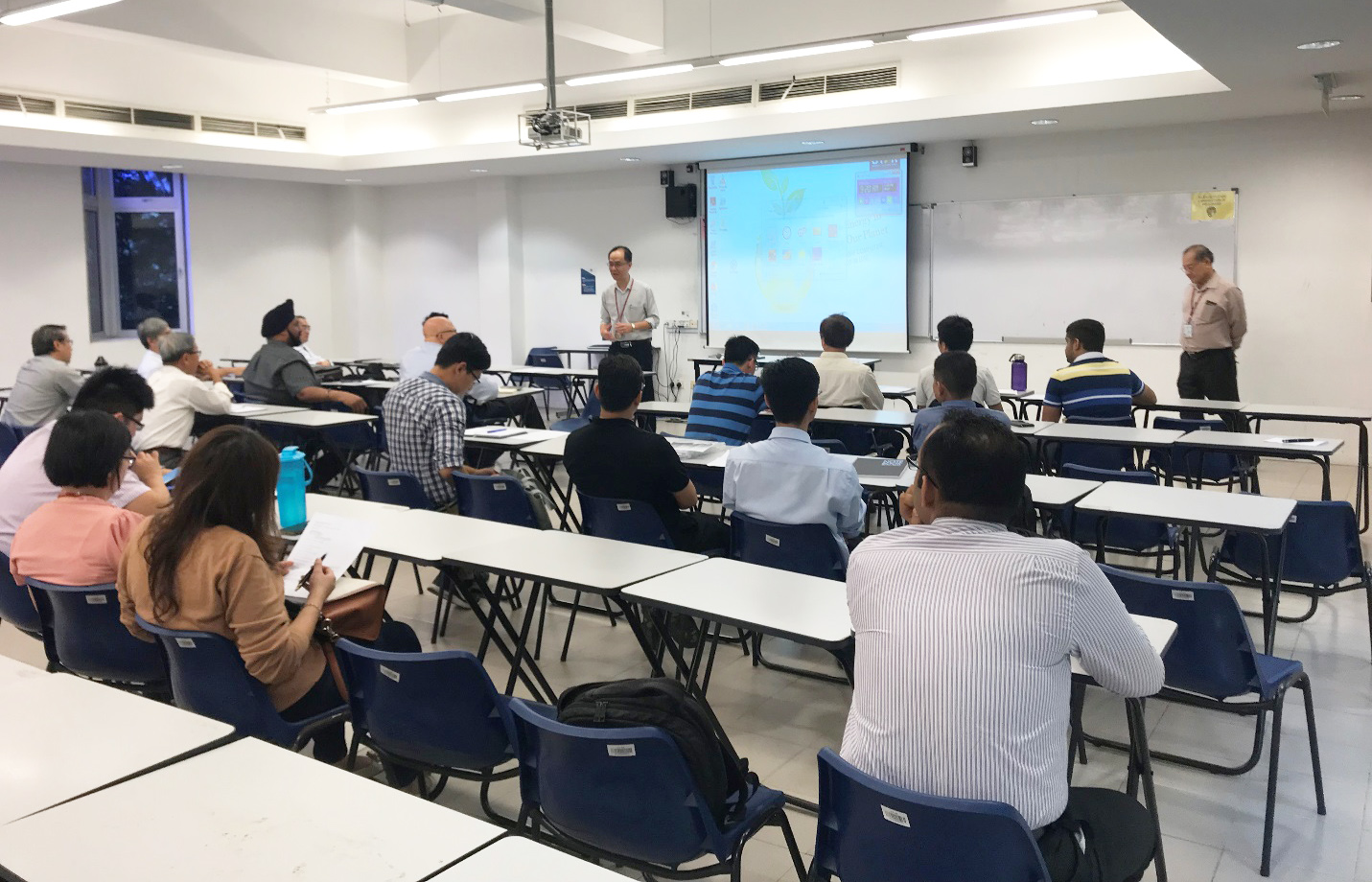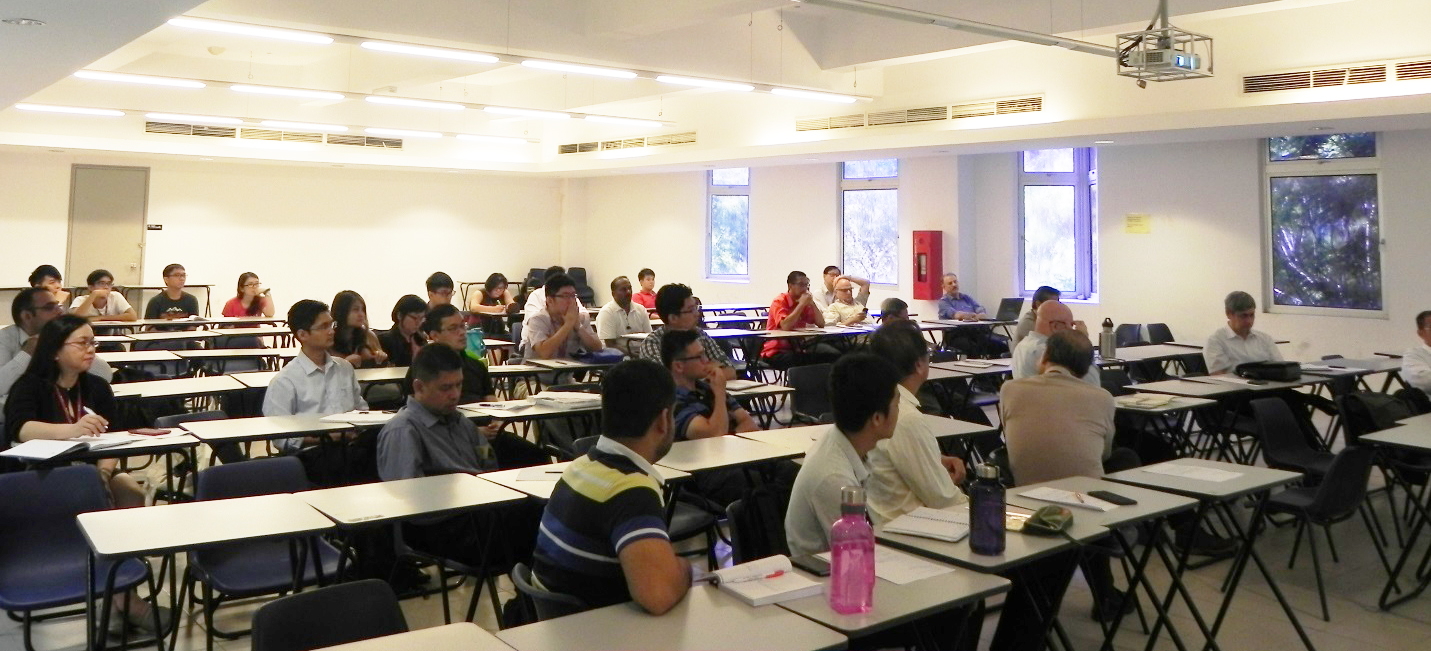

Speakers and participants at the seminar
The Centre for Environment and Green Technology (CEGT) organised a seminar titled “PV Cooling: Increased Efficiency and Longer Life Span” on 22 March 2018 at the Kampar Campus.
Present at the seminar were Faculty of Engineering and Green Technology
(FEGT) Dean Assoc Prof Dr Yap Vooi Voon, Organising Chairperson and CEGT
Chairperson Prof Ir Dr Ong Kok Seng, staff members and participants. The
speakers present at the seminar included Prof Ong, FEGT lecturer Dr Tan
Ming Hui and Assoc Prof Dr Yamuna a/p Munusamy
from UTAR, Assoc Prof Dr Hendrik Simon Cornelis Metselaar and Dr Lai
Chin Wei from University of Malaya (UM), Dr Ng Wen Bin from Universiti
Kuala Lumpur (UniKL), Dr Baljit Singh from Universiti Teknologi Mara
(UiTM), Assoc Prof Dr Syeh Ihtsham Ul Haq Gilani, Dr Jegathesan and Prof
Hussain H. Al-Kayiem from Universiti Teknologi Petronas (UTP), Dr Adnan
Ibrahim from Universiti Kebangsaan Malaysia (UKM), Development and
Testing Manager of Dunham-Bush Malaysia Sdn Bhd Dr Yau Kar Hing, Sakhr
M. Sultan from Multimedia University (MMU) and Co-founder and Project
Director of Plus Solar System Sdn Bhd Ryan Oh Zhi Kang.
The seminar aimed to gather industry players, researchers, scientists, engineers, academics, technologists, policy-makers, and entrepreneurs to discuss on the developments, latest technologies and research directions of PV cooling that will aid in the development and improvement of a green and sustainable technology. This was one of the many efforts of CEGT to develop green technology for the benefit of mankind with a minimum impact on the environment.
The seminar was divided into three sessions. The first speaker Dr Baljit, spoke on the “Experimental Investigation of Natural Convection Cooling for PV”. He mentioned that solar energy is abundantly available but its use is not widely applicable. He then explained that solar energy can be used either through direct methods such as via thermal and PV; or through indirect methods such as via water power, wind, biomass, wave energy, ocean thermal and marine currents.
“PV was recognised as an important source in the 1950s, and terrestrial PV development began in 1970s as a response to the oil crises. As concern towards the environment grew, along with the increasing global effort to seek indigenous sources of energy, investment in PV research and deployment also increased. Today, PV is billion dollar industry worldwide, with more than 520 megawatts of PV modules shipped in 2002,” said Dr Baljit.
He continued to enlighten participants with the advantages and disadvantages of PV technology compared to nuclear, coal and fuel energy; and the development of renewable energy in Malaysia. He also gave comparisons between countries on the PV-base solar electrical energy production over four decades. He also listed the materials commonly used for PV panels and the various systems used to cool the panels. He concluded by pointing out that PV systems have unique advantages and it was found that passive cooling result in highest voltage reading.
The second speaker, Dr Tan, presented his research titled “Photovoltaic Cooling with Heat Pipes and Natural Air Convection”. He explained the working principle of PV and elucidated to the participants that excessive heating will reduce the efficiency of the PVs, the power output and PV’s lifespan.
Hence, he introduced the methods used to cool the PV, namely via heat pipes and natural convection via air channel. By comparing the two cooling methods, results from his research showed that natural convection does not provide efficient cooling and there is a need to further improve the geometry or dimension of the air channel. Whereas for the heat pipe, Dr Tan explained that the PV panels were effectively cooled. Dr Tan also suggested ways to improve the cooling of PV, such as improving the surface contact between the PV and the evaporator, using better thermal adhesive and improving the aluminium fin design at the condenser. Session one ended with Dr Yamuna sharing “Application of Phase Change Material: Challenges and Future Trends”, while Dr Metselaar presented his research titled “PV Cooling with PCM”.
Session two saw speaker Dr Adnan presenting his research titled “PV Cooling with Nanofluids and PCM”, where he explained to the participants that the mixture between Nano-PCM and nanofluid within the same collector is a novel design that will see the use of Nano-PCM for thermal storage and nanofluid for cooling and thermal extraction. He also mentioned that the invention will increase thermal energy and electrical power, and help the country achieve a good performance overall.
Dr Gilani presented his research titled “Impact of PV’s panel cooling on its power yield under Malaysian climate”. Results from his research suggested that without cooling systems, the PV panels only function averagely between 16.45 percent to 17.73 percent. He then spoke in comparison when fan cooling is used, which slightly enhances the PV panel’s function but the energy used cannot be recovered, while the mist cooling increases the PV panel’s efficiency by 2.86 percent. However, Dr Gilani mentioned that with water cooling, the PV panel’s efficiency reaches the maximum.
The third session started off with the presentations on the “Effect of Super Hydrophobic and Super Hydrophilic Surfaces on the Heat Pipe Performance: A Review” and a case study on the “Improve Efficiency of Silicon Solar Cells by TiO2 Anti-reflection Coatings”, by Dr Lai and Dr Yau.
According to their research, heat transfer performance increased with surface modification of at least more than 10 percent, due to either hydrophilic or hydrophobic surfaces. They explained studies have shown that super hydrophilic surface has improved on both the evaporator and condenser and further describe that most heat pipe configuration is made from super hydrophilic evaporator and super hydrophobic condenser. Participants also learnt that transparent TiO2 coatings have self-cleaning and anti-reflection properties (AR) and are important to improve the solar panel output.
Dr Ng informed the participants that when he was researching on “PV Cooling: Thermosyphon Cooling Technique”, it was discovered that the surface temperature of PV panels decreased 5oC with the thermosyphon cooling system while using Acetone as working fluid, and the power output improved by three percent. In Dr Ng’s other research which uses petroleum jelly as latent heat storage for solar PV cooling, he mentioned that power output improved by up to eight percent.
The final speaker, Sakhr, shared his research titled “PV Cooling Technique with A Solar Water Collector”, which compare various PV solar thermal collectors. Results from his research revealed that the parallel flow absorber yielded better PV efficiency performance compared to series flow absorber design.
The seminar was supported by the Institution of Mechanical Engineers Malaysia Branch, and in collaboration with Solar/Thermal Advanced Research Center (STARC) UTP.

Dr Yap giving his welcoming remarks

Participants and speakers during the discussion
© 2019 UNIVERSITI TUNKU ABDUL RAHMAN DU012(A).
Wholly owned by UTAR Education Foundation Co. No. 578227-M LEGAL STATEMENT TERM OF USAGE PRIVACY NOTICE